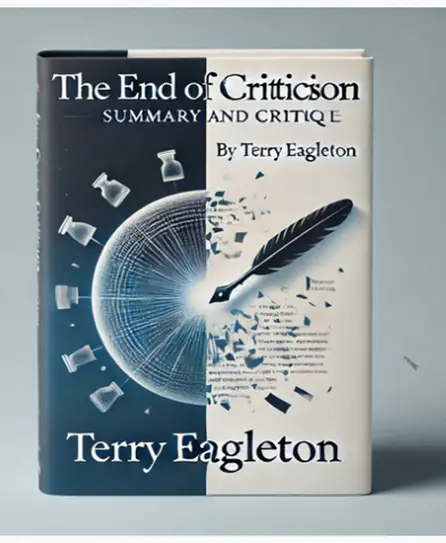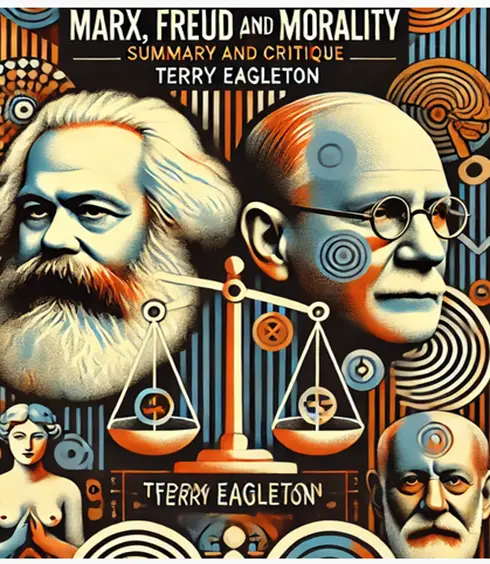
Introduction: “The End of Criticism” by Terry Eagleton
“The End of Criticism” by Terry Eagleton, first appeared in 1982 in the New Left Review journal, holds significant importance in literature and literary theory due to its provocative exploration of the decline of literary criticism in the late 20th century. Eagleton, a renowned literary theorist and Fellow of Wadham College, Oxford, argues that criticism has become increasingly marginalized and irrelevant in a postmodern era dominated by consumerism and cultural relativism. His essay challenges the prevailing assumptions about the role of criticism and offers a provocative vision for its future.
Summary of “The End of Criticism” by Terry Eagleton
The Dilemma of Socialist Literature Teaching
- Teaching Literature as Politically Relevant: Eagleton questions the political relevance of teaching literature during global capitalist crises, as most literature teachers did not choose their subject for political reasons but because of enjoyment.
- Two Traditions in Socialist Thought on Literature: There are two traditions in socialist thought regarding literature:
- Humanistic/Utopian: This tradition, including figures like Marx, Engels, and Adorno, argues that literature is relevant because it can restore creative capacities oppressed by capitalism.
- Negative Hermeneutics: The second tradition, including critics like Plekhanov and Macherey, sees literature as a tool to demystify ideological contradictions.
The Challenge of Combining Both Traditions
- Difficulty in Combining Positive and Negative Approaches: While theoretically possible, Eagleton explains that combining the two traditions in practice seems forced. If the goal is to demystify ideology, it seems odd to choose literature over more immediate forms of ideological discourse like advertisements or political speeches.
Questioning the Political Role of Literature
- Literature’s Political Defense is Flawed: Eagleton suggests that defending literature politically is increasingly challenging, as literature appears disconnected from the lives of most people. This disconnection calls into question whether literature can genuinely serve as a vehicle for political transformation.
Redefining the Role of Literary Criticism
- From Literature to Cultural Studies: Eagleton advocates for a shift from the traditional study of literature to a broader concept of “cultural studies,” which would include the analysis of ideologies, feminism, discourse, and media such as film and psychoanalysis. This shift acknowledges that literature is only one part of a broader cultural and ideological framework.
- Quotation: “Literature is the sign for that space because at the moment we have no other term: ‘cultural studies’ is certainly better.”
The Crisis of Literary Studies
- Literary Studies as a Non-Subject: Eagleton argues that literary studies do not have a unified method or object. The variety of methods, from biographical analysis to linguistic techniques, reveals the lack of coherence in the field.
- Quotation: “Methodologically speaking, literary studies are a non-subject.”
- Philology vs. Humanism: Literary studies have historically been split between the rigorous analysis of texts (philology) and the broader humanistic approach inherited from figures like Arnold and Leavis, leading to an ideological conflict within the discipline.
The Failure of Positivism in Literary Criticism
- Positivism and Humanism in Literary Criticism: Literary criticism has often tried to blend empiricism with idealism. Figures like Leavis, Frye, and New Critics sought to marry rigorous analysis with humanistic values, though this approach ultimately led to contradictions and a crisis within the field.
The Illusion of Literary Unity
- No Unity in Object or Method: Eagleton argues that there is no stable object (i.e., “literature”) or method that unites literary studies. What defines literature is often subjective, based on arbitrary decisions about what is “well written” or “valuable.”
- Quotation: “The unity of the object is every bit as illusory as the unity of the method.”
The Political End of Literary Criticism
- Rhetoric as a Replacement for Literary Criticism: Eagleton proposes replacing literary criticism with the study of rhetoric, defined as the analysis of how discourse produces effects in the social and ideological realm. This shift aligns criticism with political goals, analyzing all forms of discourse, from bus tickets to TV advertisements.
- Quotation: “Our present aim should be to abolish ‘literary criticism’ and revive rhetoric in its place.”
- Rhetoric as a Tool for Political Transformation: For Eagleton, the ultimate purpose of studying discourse is to understand and challenge its role in maintaining power structures, contributing to the broader goal of political transformation.
Conclusion: Political Transformation Through Discourse
- Literature’s Role in Ideological Critique: Eagleton suggests that instead of viewing literary criticism as an isolated practice, it should be incorporated into broader political critique. The study of discourse, whether literary or otherwise, should focus on its political and ideological effects, with the aim of contributing to revolutionary culture.
Literary Terms/Concepts in “The End of Criticism” by Terry Eagleton
| Term/Concept | Explanation |
| Humanistic/Utopian Tradition | A tradition in socialist thought that views literature as politically relevant because it can help restore creative capacities oppressed by capitalism. |
| Negative Hermeneutics | A critical approach that uses literature to expose and demystify ideological contradictions, viewing literature as a tool for ideological critique. |
| Demystification | The process of revealing and critiquing hidden ideologies within cultural products (like literature) that support capitalist or bourgeois society. |
| Philology | The study of texts through linguistic, historical, and textual criticism, often seen as a more rigorous, technical, and professional approach to literature. |
| Bourgeois Humanism | A tradition in literary studies, particularly associated with figures like Arnold and Leavis, emphasizing the humanistic and moral dimensions of literature. |
| Positivism | An empirical approach that seeks to apply scientific methods to literary criticism, aiming for objective and systematic analysis. |
| Rhetoric | Eagleton advocates for reviving rhetoric, the study of how discourse (any form of communication) produces effects, linking it to the analysis of power and ideology. |
| Discourse | Broadly refers to any form of communication (literature, film, advertisements, etc.), focusing on its ideological effects and the ways it constructs social relations. |
| Cultural Studies | A proposed replacement for traditional literary studies, encompassing a broader analysis of cultural practices, ideologies, and discourses beyond just literature. |
| Ideology Critique | The analysis of how cultural products, including literature, reinforce or challenge dominant ideologies, often used in Marxist criticism. |
| Liberal Humanism | A tradition in literary criticism focused on the moral, ethical, and humanizing effects of literature, often criticized for its idealistic or abstract approach to literature. |
| Structuralism | A theoretical approach that analyzes cultural phenomena (including literature) through the underlying structures and systems (such as language or signs) that shape them. |
| Signifying Practices | Refers to the ways in which signs, symbols, and discourses create meaning within cultural and ideological contexts. |
| Performative | A term from speech act theory (introduced by Austin), focusing on how discourse not only describes the world but also acts to produce effects in the world. |
Contribution of “The End of Criticism” by Terry Eagleton to Literary Theory/Theories
Critique of Traditional Literary Studies
- Challenges the Unity of Literary Studies: Eagleton argues that literary studies lack a coherent method or object, making them a “non-subject” in academic discourse.
- Quotation: “Methodologically speaking, literary studies are a non-subject.”
- Questions the Relevance of Literature in Ideological Critique: Eagleton critiques the idea that literature, especially “high” literature, is the best tool for ideological critique in a capitalist society.
- Quotation: “Why lay bare the operations of ideology in D. H. Lawrence rather than in television advertisements, women’s magazines, and John Locke?”
Shift from Literature to Cultural Studies
- Proposes Expanding Literary Criticism into Cultural Studies: Eagleton suggests broadening the field to encompass other signifying practices like film, advertisements, and everyday life, calling for a shift to “cultural studies.”
- Quotation: “‘Literature’ is the sign for that space because at the moment we have no other term: ‘cultural studies’ is certainly better.”
Revival of Rhetoric as a Critical Tool
- Advocates for the Return of Rhetoric: Eagleton calls for the revival of rhetoric, not just as the study of literary devices but as an analysis of how any discourse produces social and ideological effects.
- Quotation: “Our present aim should be to abolish ‘literary criticism’ and revive rhetoric in its place.”
Politicization of Literary Criticism
- Promotes Politically Engaged Criticism: Eagleton emphasizes the need for literary criticism to be explicitly political, aligning itself with broader social and revolutionary goals.
- Quotation: “It is a unity not of discourses or objects but of intentional practices… It is a question, not of what we do to ‘literature’ or what ‘literature’ does to us, but of what all this doing is for in the first place.”
Criticism of Humanist and Positivist Approaches
- Critiques the Humanist and Positivist Blending in Literary Criticism: Eagleton critiques the hybrid of idealism and positivism found in much of modern literary criticism, particularly in the works of figures like Leavis and Frye.
- Quotation: “Leavis and Richards yoked the distressing vagueness of Arnoldian humanism to the thorough business of technical analysis.”
Destabilization of the Literary Canon
- Questions the Definition of “Literature” as a Distinct Object: Eagleton destabilizes the idea of literature as a unified, inherently valuable object, arguing that the categorization of literature is socially and ideologically constructed.
- Quotation: “You have a choice between maintaining the increasingly implausible thesis that there is indeed an inherently definable object named Literature… or of frankly conceding that they have something in common because you and your friends have decided that they do.”
Pluralistic Approach to Discourse Analysis
- Advocates for Methodological Pluralism in Criticism: Eagleton promotes a pluralistic approach to the study of discourse, allowing for various methods as long as they contribute to the political goal of ideological critique.
- Quotation: “Rhetorical critics are unashamed pluralists: anything which contributes to the goal of political transformation is acceptable.”
Examples of Critiques Through “The End of Criticism” by Terry Eagleton
| Literary Work | Critique Through Eagleton’s Framework |
| D. H. Lawrence’s Sons and Lovers | Critique through Negative Hermeneutics: Instead of focusing on its literary qualities, Eagleton would argue for using Sons and Lovers to reveal the ideological contradictions in Lawrence’s representation of family and individual desire. This novel could be seen as crystallizing middle-class anxieties around sexuality and social mobility under capitalism. Quotation: “Why lay bare the operations of ideology in D. H. Lawrence rather than in television advertisements, women’s magazines, and John Locke?” |
| William Blake’s Songs of Innocence and Experience | Critique through Utopian-Humanistic Tradition: Blake’s poetry, particularly in Songs of Innocence and Experience, could be analyzed as an expression of the human spirit’s creative potential, oppressed by industrial capitalism. Eagleton would likely see value in Blake’s visionary literature for restoring awareness of human capacities that capitalism represses. Quotation: “Literature is politically relevant because it can restore to us that sense of creative capacities repressed by capitalism and realisable under socialism.” |
| Jane Austen’s Pride and Prejudice | Cultural Critique and Rhetoric: Through Eagleton’s framework, Pride and Prejudice could be critiqued not only for its subtle social critique but for its role in reinforcing class ideologies and bourgeois morality. The novel’s discourse on marriage and class mobility can be analyzed as a reflection of how literature produces and sustains bourgeois ideology. Quotation: “Our present aim should be to abolish ‘literary criticism’ and revive rhetoric in its place. By rhetoric, I mean the study of the ways in which any discourse whatsoever produces its effects.” |
| James Joyce’s Ulysses | Destabilization of the Literary Canon: Eagleton would critique Ulysses not for its modernist innovations but for how literary critics and institutions have canonized it as a symbol of high culture, reinforcing elitist distinctions between “literature” and other cultural forms. Joyce’s work, though experimental, does not inherently possess more value than other forms of discourse like advertisements or films. Quotation: “You have a choice between maintaining the increasingly implausible thesis that there is indeed an inherently definable object named Literature… or of frankly conceding that they have something in common because you and your friends have decided that they do.” |
Criticism Against “The End of Criticism” by Terry Eagleton
Overemphasis on Political Criticism
- Reduction of Literature to Ideology: Critics argue that Eagleton reduces all literary value to its political and ideological functions, ignoring aesthetic, emotional, or philosophical aspects of literature that might transcend political contexts.
- Counterpoint: By focusing solely on political engagement, the richness and diversity of literary experiences are overlooked.
Dismissal of Aesthetic and Humanistic Values
- Neglect of Aesthetic Appreciation: Eagleton’s critique dismisses the idea that literature can be appreciated purely for its artistic or humanistic qualities, such as beauty, emotional resonance, or exploration of universal themes.
- Counterpoint: Critics argue that literature offers more than political utility, and limiting it to that role undermines its broader cultural and artistic contributions.
Undermining the Literary Canon
- Destabilizing the Canon is Problematic: By challenging the very concept of a “literary canon,” Eagleton opens the door to a relativistic view where the distinction between high literature and other forms of discourse, such as advertisements, becomes blurry.
- Counterpoint: This could lead to the devaluation of literary studies and weaken the defense of literature as an important cultural practice.
Excessive Pluralism in Methodology
- Lack of Rigor in Pluralistic Approach: Eagleton’s call for methodological pluralism, where any approach that serves political transformation is valid, can be criticized for lacking academic rigor or coherence.
- Counterpoint: The absence of a unified method might lead to an incoherent or fragmented field of study, reducing the legitimacy of literary criticism as an academic discipline.
Marginalization of Traditional Literary Scholarship
- Rejection of Traditional Scholarship: Eagleton’s critique marginalizes traditional literary scholarship (such as philology, textual criticism, and close reading), which has been fundamental to the field. This dismissal undermines centuries of academic work and critical analysis.
- Counterpoint: Critics argue that traditional methods have value in understanding texts, their historical context, and their formal properties, even outside political dimensions.
Idealism in the Call for Revolutionary Culture
- Utopian Call for Revolutionary Culture: Eagleton’s call for literary studies to contribute to the creation of revolutionary culture may be seen as overly idealistic or impractical, especially in contemporary academic institutions.
- Counterpoint: This focus on revolutionary culture might alienate scholars who are not politically radical or aligned with socialist ideology.
Limited Scope in Defining Discourse
- Narrow Definition of Discourse: Eagleton’s expansion of discourse to include all cultural texts (e.g., advertisements, bus tickets) risks trivializing the study of literature by treating it as one among many discourses, without acknowledging its unique characteristics or impact.
- Counterpoint: By equating literature with other discourses, Eagleton potentially minimizes the distinctive role that literature has played in shaping cultural, philosophical, and artistic thought.
Representative Quotations from “The End of Criticism” by Terry Eagleton with Explanation
| Quotation | Explanation |
| “Literary studies are a non-subject.” | Eagleton critiques the lack of a unified method or coherent subject in literary studies, arguing that the field is fragmented and inconsistent in its methodologies and objectives. |
| “Literature is politically relevant because it can restore to us that sense of creative capacities repressed by capitalism.” | This quotation reflects the utopian-humanistic tradition in socialist thought, where literature is seen as having the potential to reawaken human creativity, which is otherwise suppressed under capitalist systems. |
| “Why lay bare the operations of ideology in D. H. Lawrence rather than in television advertisements, women’s magazines, and John Locke?” | Eagleton questions why literature, particularly high literature, is chosen as the primary tool for demystifying ideology when other cultural forms, such as advertisements or popular media, may have a more direct impact on people’s lives. |
| “Our present aim should be to abolish ‘literary criticism’ and revive rhetoric in its place.” | Eagleton advocates for a shift from traditional literary criticism to the study of rhetoric, which he defines as analyzing how any form of discourse produces its effects, including ideological and social influences. |
| “The unity of the object is every bit as illusory as the unity of the method.” | Here, Eagleton critiques the notion that literature is a stable and unified object of study, arguing that the definition of “literature” is arbitrary and ideologically constructed, just as there is no singular method that governs its study. |
| “Rhetorical critics are unashamed pluralists: anything which contributes to the goal of political transformation is acceptable.” | Eagleton promotes a pluralistic approach to criticism, arguing that any method or discourse that aids in political transformation is valid, rejecting the idea that literary criticism must adhere to strict or traditional methods. |
| “Socialism is moral or it is nothing.” | Eagleton emphasizes that the core of socialism, and by extension socialist literary criticism, is moral in nature. It is motivated by the ethical objection to the exploitation and degradation of human lives under capitalist systems. |
| “You have a choice between maintaining the increasingly implausible thesis that there is indeed an inherently definable object named Literature… or of frankly conceding that they have something in common because you and your friends have decided that they do.” | Eagleton critiques the arbitrary nature of literary canon formation, suggesting that what counts as “literature” is not an inherent quality of texts but a decision made by those in positions of cultural power. |
| “It is a unity not of discourses or objects but of intentional practices.” | Eagleton argues that the “unity” of literary studies should not be found in methods or objects (i.e., literary texts), but in the political intentions and practices of those who engage with the discipline. |
| “The study of what has traditionally been called literature will not of course merely dissolve within this new space.” | Although Eagleton calls for a shift towards cultural studies and rhetoric, he acknowledges that the study of traditional literature will not disappear entirely but will become one part of a broader, more inclusive field focused on cultural critique. |
Suggested Readings: “The End of Criticism” by Terry Eagleton
- Eagleton, Terry. Literary Theory: An Introduction. University of Minnesota Press, 2008.
https://www.upress.umn.edu/book-division/books/literary-theory - Jameson, Fredric. The Political Unconscious: Narrative as a Socially Symbolic Act. Cornell University Press, 1981.
https://www.cornellpress.cornell.edu/book/9780801492228/the-political-unconscious - Macherey, Pierre. A Theory of Literary Production. Routledge, 1978.
https://www.routledge.com/A-Theory-of-Literary-Production/Macherey/p/book/9780415386636 - Williams, Raymond. Marxism and Literature. Oxford University Press, 1977.
https://global.oup.com/academic/product/marxism-and-literature-9780198760610 - Althusser, Louis. Lenin and Philosophy and Other Essays. Monthly Review Press, 1971.
https://monthlyreview.org/product/lenin_and_philosophy_and_other_essays/ - Eagleton, Terry. The Function of Criticism: From The Spectator to Post-Structuralism. Verso, 1984.
https://www.versobooks.com/products/1118-the-function-of-criticism - Foucault, Michel. The Archaeology of Knowledge. Pantheon Books, 1972.
https://www.penguinrandomhouse.com/books/173185/the-archaeology-of-knowledge-by-michel-foucault/ - Said, Edward W. The World, the Text, and the Critic. Harvard University Press, 1983.
https://www.hup.harvard.edu/catalog.php?isbn=9780674961876 - Lentricchia, Frank. After the New Criticism. University of Chicago Press, 1980.
https://press.uchicago.edu/ucp/books/book/chicago/A/bo5960662.html - “Terry Eagleton on The Function of Criticism.” Verso Books Blog, 27 Feb. 2017.
https://www.versobooks.com/blogs/3127-terry-eagleton-on-the-function-of-criticism








